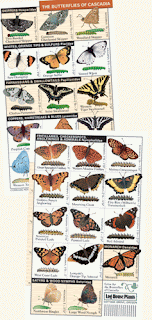I want more butterflies in my garden so I’m embarking on the Butterfly Bed & Breakfast Challenge! I’d love it if you’d join me.
Happiness is a butterfly, which, when pursued, is always just beyond your grasp, but which, if you will sit down quietly, may alight upon you.
– Nathaniel Hawthorne
Log House Plants, a wholesale grower of very cool plants located in Cottage Grove, is introducing a Butterfly Bed & Breakfast program because they want to see more butterflies in our gardens and fields. I couldn’t agree more, but it turns out, I don’t offer many “hotel” options for these “flying flowers,” as Alice Doyle, co-owner of the nursery, calls them. I also need to determine how many nectar plants I’m offering. Thus the challenge to you—should you choose to accept—and me to plant more butterfly host and nectar plants so we can become popular destinations for these beautiful insects.
I learned a lot about butterflies and their lifecycles while reading the information on the nursery’s Web site and talking to Alice:
• There are 160 butterflies native to Cascadia, the area west of the Cascades between Vancouver, BC, and San Francisco.
• There are only a few, sometimes only one, species of host plant that young caterpillars of each butterfly species can safely eat, and they often eat only one part of the plant. Host plants contain the precise chemical properties essential to make caterpillars a distasteful snack for their predators,
• The female butterfly searches for the host plant by testing them with specialized tasting hairs on her legs. [Editor’s note: gasp!]
• Caterpillars outgrow their skins, shedding them up to six times depending on the species. Each time they shed their skin, they change a little, becoming hairier, often changing color, and sometimes growing spines and horns, as they mature.
• Butterflies fly on sunny days with temperatures above 60° F. and are most active above 80° F. On overcast days and during the night, they often roost on tall weeds and in the tops of shrubs and small trees. When it rains, they may shelter under leaves and in clumps of plants.
• Group host plants rather than planting singularly. Planting three or five of each variety increases the chances that the female will find the plants.
• We should tidy our gardens selectively, even in winter, protecting places where butterflies, chrysalides, caterpillars, and eggs might be taking refuge.
• Butterflies need water and mineral salts, which why you’ll see them in muddy depressions.
Eliminating the use of herbicides and pesticides in our gardens is an important step to extending native butterfly habitat. Log House Plants recommends two books on butterflies, both written by Robert Michael Pyle: The National Audobon Society’s Field Guide to North American Butterflies and the Handbook for Butterfly Watchers.
Download Log House Plant’s beautiful color artwork of 29 butterflies and their caterpillars and the list of related host plants. Spread the word and share these tools with your kids, neighbors, family members and fellow gardeners.
 » Butterfly Bed & Breakfast Varieties List
» Butterfly Bed & Breakfast Varieties List
» Butterfly Hosting Plants
» Beautiful Color Artwork of 29 Butterflies and their Caterpillars
To find retailers that might carry Log House Plant’s Butterfly B&B plants, visit their Web site, but call ahead first to make sure they have them in stock. Alice told me Portland Nursery has the largest selection right now in the Portland area; Jerry’s Home Improvement Center in Eugene and Springfield are carrying the largest selection in Oregon at the moment. Shopping at nurseries that carry or specialize in native plants is also an option.
Will you join me in planting more butterfly host plants? I’ll let you know how my garden progresses on this challenge.

